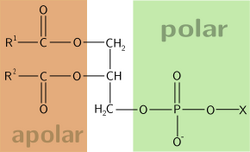Phospholipid Fibers
Phospholipids are a class of lipids and are a major component of all cell membranes. Most phospholipids contain a diglyceride, a phosphate group, and a simple organic molecule such as choline; one exception to this rule is sphingomyelin, which is derived from sphingosine instead of glycerol. They are a type of molecule. They form a lipid bilayer within a cell membrane. They also transport DNA.
Amphipathic character[edit]
The 'head' of a phospholipid is hydrophilic (attracted to water) whereas the hydrophobic 'tails' repel water. The hydrophillic head contatins the negatively charged phosphate group, and may contain other polar groups. The hydrophobic tail usually consists of long fatty acid hydrocarbon chains. When placed in water, phospholipids form a variety of structures depending on the specific properties of the phospholipid. These specific properties allow phospholipids to play an important role in the phospholipid bilayer. In biological systems, the phospholipids often occur with other molecules (e.g., proteins, glycolipids, cholesterol) in a bilayer such as a cell membrane. Lipid bilayers occur when hydrophobic tails line up against one another, forming a membrane with hydrophilic heads on both sides facing the water.
This membrane is partially permeable, capable of elastic movement, and has fluid properties, in which embedded proteins (integral or peripheral proteins) and phospholipid molecules are able to move laterally. Such movement can be described by the Fluid Mosaic Model, that describes the membrane as a mosaic of lipid molecules that act as a solvent for all the substances and proteins within it, so proteins and lipid molecules are then free to diffuse laterally through the lipid matrix and migrate over the membrane. Cholesterol contributes to membrane fluidity by hindering the packing together of phospholipids. However, this model has now been superseded, as through the study of lipid polymorphism it is now known that the behaviour of lipids under physiological (and other) conditions is not simple.
Also, the hydrophilic and hydrophobic ends allow the phospholipids to transfer and be associated with water. It is able to be resistant and associate with it at the same time. This happens because only one end of the molecule is soluble in water.
Phospholipid Synthesis[edit]
Phospholipid synthesis occurs in the cytosol adjacent to ER membrane that is studded with proteins that act in synthesis (GPAT and LPAAT acyl transferases, phosphatase and choline phosphotransferase) and allocation (flippase and floppase). Eventually a vesicle will bud off from the ER containing phospholipids destined for the cytoplasmic cellular membrane on it's exterior leaflet and phospholipids destined for the exoplasmic cellular membrane on its inner leaflet.
